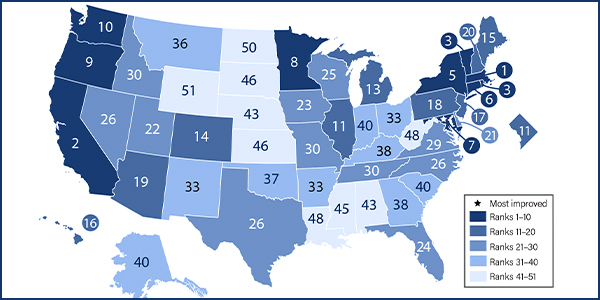By Amanda Durish Cook
Coastal regions are picking up steam in implementing energy efficiency, while areas in Middle America are either stalled or backsliding, according to the latest annual ranking of states’ individual measures.
Massachusetts led the American Council for an Energy-Efficient Economy’s 13th annual State Energy Efficiency Scorecard for the ninth consecutive year. California came in a close second, while Rhode Island and Vermont followed in a tie for third place.
During a webinar Tuesday, ahead of the report’s release, ACEEE researcher and report author Weston Berg said Massachusetts’ lead is the result of “groundbreaking” building codes, emissions standards and appliance programs.
To rank the states, Berg said he and other researchers examined states’ utility regulations, building codes and transportation policy in 2018.
“Energy efficiency is sometimes overlooked as an invisible resource,” said Berg, adding that a strong energy efficiency strategy can help states meet emissions targets, reduce air pollutants, create jobs and reduce energy burdens in areas with tight supplies.
All told, states spent $8 billion on energy efficiency in 2018 and saved 27.1 million MWh — 0.73% of total retail electricity sales in the country, enough energy to power 2.6 million homes for a year, ACEEE said. However, that figure is 0.5% less than the 27.27 million MWh saved in 2017.
ACEEE Senior Director of Policy Maggie Molina said the scorecard allows state leaders to compare against each another and “spur some friendly competition.”
Molina said Maryland improved more than any other state in a year-over-year comparison, gaining ground — and three slots to a No. 7 ranking — through utility efficiency programs, stronger building energy codes, public transit funding and electric vehicle adoption.
Massachusetts Department of Energy Resources Commissioner Judith Judson said energy efficiency efforts are the single greatest factor in meeting the state’s 25% reduction goal in greenhouse gas emissions from 1990 levels.
“It’s not just about ranking us against each other … but to learn from each other on programs that really work,” Judson said.
Chris Rice, acting chief of staff of the Maryland Energy Administration, said his state rose in the rankings because of regularly updated building codes and the EmPOWER Maryland initiative, which established energy savings goals on a per capita basis. Rice said the program is effective because it extends to low-income households.
“This is a very important aspect of our program: that everyone is served and able to participate in our program,” Rice said.
New York also maneuvered back into the top five this year thanks to adopting targets to shrink energy consumption by 185 trillion Btu by 2025 and procuring its electricity from 100% carbon-free sources by 2040.
“If states embrace robust energy-saving measures nationwide, Americans can slash greenhouse gas emissions by 50% and deliver more than $700 billion in energy savings by 2050,” ACEEE Executive Director Steve Nadel said in a release.
Kentucky and Ohio lost significant ground this year, according to the report. The report also put North Dakota and Wyoming behind all other states.
Kentucky’s downgrade is the result of regulators in 2018 “drastically cutting” most consumer-facing energy management programs by Kentucky Power and other utilities, Berg said.
Berg said Ohio is set to backslide on efficiency with the passage of its nuclear bailout bill, which also lowers the state’s existing energy efficiency savings standard for utilities from 22% to 17.5% by 2020. Berg said the bill will cause lower investment in renewables and energy efficiency, and it’s “very unlikely” efficiency programs will continue in the future because utilities are already on the verge of meeting the goal. While Ohio is still achieving energy savings, the state’s rank will likely fall in the coming years because of the legislation, he said.




